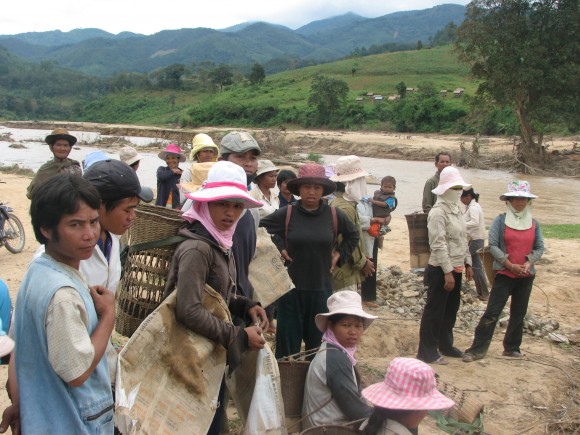Case-study /
Building Community Resilience to Disasters in Upland Areas of Vietnam (BCRD)


Project overview
The highland areas of Vietnam, where ethnic minorities are the main inhabitants, are particularly vulnerable to the consequences of climate change. In 2007, CECI and the French NGO ACTED launched a far-reaching prevention program in the Kon Tum province. Following many successes, a new phase was initiated in three communes of the Nghe An province.
In 2009, four days of torrential rain and a flash flood swept away fifty houses and destroyed many crops and livestock. Months later, drought and fires ravaged the crops of one sector, where more than 85% of the population live on subsistence farming.
To reduce the vulnerability of ethnic minorities to these disasters, CECI and ACTED employed a participatory approach. Representatives of the target communities were trained to organize awareness-raising workshops within their villages. Using this approach, the communities’ priority needs could then be identified and targeted: mapping of high risk areas, implementing early warning and evacuation systems, first aid training, etc. Dikes have also been built to prevent further floods and to reclaim farm land.
The project also includes children from primary and secondary schools. A teacher from the Quy Hop province says, “By working in the schools, we ensure that we are protecting the people most vulnerable to climate change: the youth. Through them, we are also reaching their families and therefore all of the community.”
The project has borne fruit. In June, typhoon Haima ravaged the Chau Dinh commune. The early warning systems ensured the evacuation of the village before it was hit by a three-metre high flood. Encouraged by this success, the project team is actively working with local authorities to expand this winning formula to a national level.
Project sites
- Kon Tum Province in the following districts: Tu Mo Rong (villages of Dak Ro Ong, Dak To Kan, and Van Xuoi) and Kon Ray (villages of Dak Coi and Dak To Long);
- Nghe An Province in the district of Quy Hop (villages of Lien Hop, Chau Dinh, and Chau Loc)
Lessons learned
1. Few agencies have worked with ethnic minorities within upload areas in Viet Nam on Disaster Risk Reduction (DRR). The project learnt the importance of piloting, testing, closely monitoring, reiterating, conducting refresher courses, repeating events, and only expanding those activities that proved to reduce the impact of disasters. Such an approach takes considerable time and patience, as well as openness to explore what working, what didn’t, and why. 2. It is important to work with current strategies and structures to increase ownership and sustainability of DRR activities. Working with local government systems (province, district, and commune) helps increase officials’ capacity to do DRR work, whilst engagement with mass organisations helps reach their membership in remote and scattered communities. 3. Involving all local layers of government (province, district and commune) is crucial due to the different roles they play in advocating for and rolling-out the project (provincial level), in supporting and mentoring (district-level), and in training and implementation (commune level). 4. Awareness-raising activities must be done in the local ethnic language. This can be achieved through using local district and commune trainers who know the language in addition to Vietnamese. Awareness-raising tools should use more pictures representative of the target area and less text, with trainers available to explain the picture messages. 5. Learning by doing is the preferred method to teach people about DRR. In particular the simulation drill of a disaster happening where emergency equipment and teams are tried and tested helped save lives during Typhoon Ketsana (2009. 6. Using fun activities helps attract and engage people during awareness-raising events. Evening cultural events, drama, songs, quizzes, and competitions are popular ways of raising awareness amongst ethnic minority communities. 7. Early warning services such as rain gauges need to be simple and reliable as well as easy to maintain and operate if local authorities are to use and rely on such services. 8. Investment in appropriate communication services within upland areas (such as wireless systems) can prove beneficial to disseminate disaster warning messages as well as for DRR awareness-raising purposes. 9. The use of participation was new for the ethnic communities as well as for district and commune trainers. The project had to invest considerable resources in teaching participatory techniques before engaging in DRR activities. 10. Digital hazard maps are useful tools for archiving disasters and for planning purposes. The government’s scheme to relocate households out of hazardous areas made use of the hazard maps. Communities however found digital hazard maps too complex to understand, with signboards in high risk areas being a more understandable awareness-raising tool.
Funding Organisation
European Commission Humanitarian Aid Office
Potential Beneficiaries
22,671 people (population of 8 communes)
Budget
Phase III: Can $ 600 000, funding from the Humanitarian Aid and Civil Protection service of the European Commission (ECHO).
Coverage
Phase III: June 2010 – August 2011
- Building Community Resilience to Disaster Phase III Project Description Sheet
- Building Community Resilience to Disasters in Upland Areas of Vietnam: Lessons Learnt
- Framework on Community Based Disaster Risk Management in Vietnam
- Experience sharing on the Vulnerability & Capacity Assessment (Vietnamese)
- Experience Sharing on the Vulnerability & Capacity Assessment (English)
- Community-based Early Warning Systems- A Best Practice Guide
- Disaster Risk Reduction Educational Initiatives for School Children
